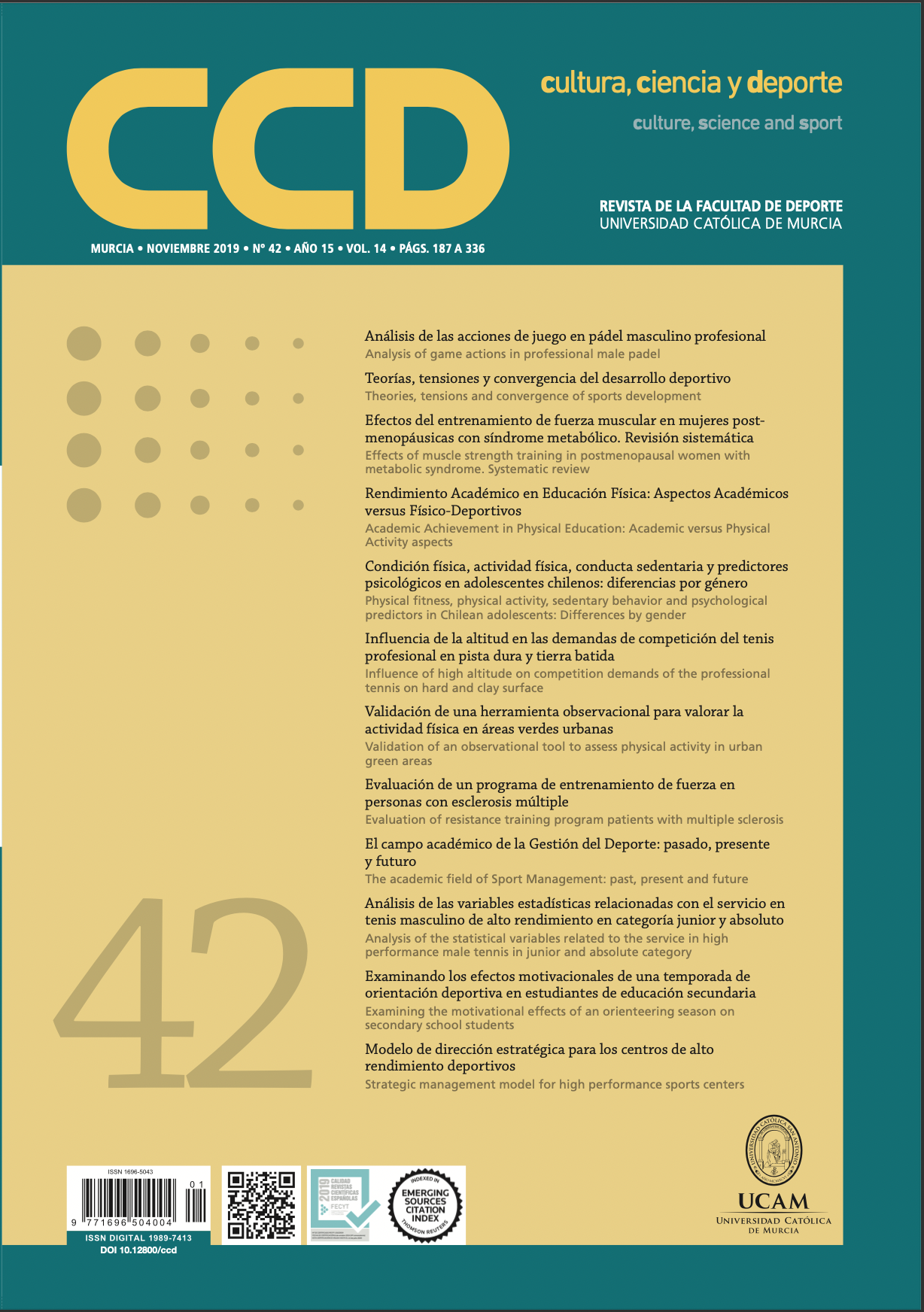Evaluación de un programa de entrenamiento de fuerza en personas con esclerosis múltiple. (Evaluation of resistance training program patients with multiple sclerosis)
DOI:
https://doi.org/10.12800/ccd.v14i42.1340Keywords:
Entrenamiento de fuerza, equilibrio, composición corporal y calidad de vida.Abstract
Objetivo: evaluar los efectos de un programa de 10 semanas de entrenamiento de fuerza muscular en pacientes con Esclerosis Múltiple. Métodos: con un grupo de once sujetos (7 mujeres y 4 hombres) con esclerosis múltiple, con un rango en la puntuación de la escala “Expanded disability status scale” entre 6 y 8, edad media de 46.45 ± 6.89 años, se realizó un programa de fuerza de 10 semanas, a razón de dos sesiones por semana, complementadas con una sesión fisioterapéutica. La muestra fue dividida entre participantes ambulantes y no ambulantes. Se llevaron a cabo mediciones de fuerza, equilibrio, composición corporal y calidad de vida antes y después del programa de intervención. Resultados: se encontraron diferencias significativas en las variables de carga (kg), fuerza media total (N), fuerza máxima (N), potencia media total (W) en la prueba press de banca y sentadilla en el grupo ambulante, y en el grupo no ambulante en test de extensión de hombro; y en las variables de relaciones interpersonales, salud física y psicológica, en el cuestionario “WHOQOL-BREF”. No se observaron diferencias significativas en las variables de equilibrio y composición corporal. Conclusiones: un programa de entrenamiento de fuerza de 10 semanas de duración, en pacientes con esclerosis múltiple con una puntuación entre 6 y 8 en la escala “Expanded disability status scale” consiguió mejoras a nivel psicológico, social y físico. Con respecto a la fuerza, se encuentran mejoras que podrían mejorar la funcionalidad en la realización de las actividades de la vida diaria. Por otro lado, no se encontraron diferencias en el test del equilibrio y tampoco en la composición corporal de ambos grupos.
=
Objective: To evaluate the effects of a 10-week resistance training program in patients. Methodology: A group of eleven subjects (7 women and 4 men) with multiple sclerosis with a range in the “Expanded disability status scale” score between 6 and 8, mean age 46.45 ± 6.89 years-old, participated in this investigation. It was carried out a 10-week resistance program, twice per week, complemented with a physiotherapy session. Sample was divided in walking group and in the non-walking group. Measurements of strength, balance, body composition and quality of life were taken before and after the intervention program. Results: Significant differences were found in the variables load (kg), total medium strength (N), maximum strength (N), total medium power (W) in the bench press and squat in the walking group and in shoulder extension test in the non-walking group; and interpersonal relationships, physical and psychological health, by the application of “WHOQOL -BREF” questionnaire. There were no significant differences in balance and body composition variables. Conclusion: The 10-week strength training program in patients with multiple sclerosis with a score between 6 and 8 on the scale “Expanded disability status scale” showed improvements at a psychological, social and physical levels. About strength variables, it was found improvements that could improve functionality in the activities of daily life. Furthermore, balance test and body composition did not show significant changes in both groups.
References
Ayán, C.L. (2006). Esclerosis Múltiple y Ejercicio Físico. Sevilla: Wanceulen.
Batista, S., Teter, B., Sequeira, K., Josyula, S., Hoogs, M., Ramanathan, M., Benedict, R.H.B., & Weinstock-Guttman, B. (2012). Cognitive impairment is associated with reduced bone mass in multiple sclerosis. Multiple Sclerosis Journal, 18(10), 1459-1465. doi:10.1177/1352458512440206
Burks, J. S. & Jhonson, K.P. (2000). Multiple Sclerosis: Diagnosis, Medical Management and Rehabilitation. Demos Publication. New York.
Calero, M. D., Hernández, I., López, E., & Zafra, I. (2002). Actuación del fisioterapeuta en esclerosis múltiple. Granada: Alcalá.
Carvalho, A., Sant’Anna, G., Santos, C. S., Frugulhetti I. P., León, S. A., & Quirico-Santos, T. (2003). Determinaçao de autoanticorpos para antígenos de mielina no soro de pacientes HLA-DQB1*0602 com esclerose múltipla. Arquito de neuro-psiquitaría, 61(4), 968-973.
Cruickshank, T. M., Reyes, A. R., & Ziman, M. R. (2015). A systematic review and meta-analysis of strength training in individuals with multiple sclerosis or Parkinson disease. Medicine, 94(4), e411. doi:10.1097/ MD.0000000000000411
Dalgas, U., Stenager, E., Jakobsen, J., Petersen, T., Overgaard, K., & Ingemann-Hansen, T. (2010). Muscle fiber size increases following resistance training in multiple sclerosis. Multiple Sclerosis, 16(11), 1367-1376. doi:10.1177/1352458510377222
Dalgas, U., Stenager, E., Lund, C., Rasmussen, C., Petersen, T., Sorensen, H., & Overgaard, K. (2013). Neural drive increases following resistance training in patients with multiple sclerosis. Journal of Neurology, 260(7), 1822-1832. doi:10.1007/s00415-013-6884-4
De Souza-Teixeira, F., Costilla, S., Ayán, C., García-López, D., GonzalezGallego, J., & De Paz-Fernádez, J. (2009). Effects of resistance training in multiple sclerosis. International Journal of Sports Medicine, 30(4), 245-250. doi:10.1055/s-0028-1105944
De Souza-Teixeira, F., Gonzalo, R. F., Murúa, J. A. H., Bresciani, G., Gutierrez, A. J., & Fernández, J. A. D. P. (2011). Elastic band training for multiple sclerosis patients: a pilot study. Journal of Physical Therapy Science, 23(2), 307-311. doi:10.1589/jpts.23.307
Dobson, R., Ramagopalan, S., & Giovannoni, G. (2012). Bone health and multiple sclerosis. Multiple Sclerosis Journal, 18(11), 1522-1528. doi:10.1177/1352458512453362
Dodd, K., Taylor, N., Denisenko, S., & Prasad, D. (2006). A qualitative analysis of a progressive resistance exercise programme for people with multiple sclerosis. Disability & Rehabilitation, 28(18), 1127-1134. doi:10.1080/09638280500531842
Dodd, K., Taylor, N., Shields, N., Prasad, D., McDonald, E., & Gillon, A. (2011). Progressive resistance training did not improve walking but can improve muscle performance, quality of life and fatigue in adults with multiple sclerosis: a randomized controlled trial. Multiple Sclerosis Journal, 17(11), 1362-1374. doi:10.1177/1352458511409084
Enrat Prim (SD). Biodex Balance System. Revisado el 2 de junio de 2014.
Federación Internacional de Esclerosis Múltiple (MSIF). Revisado el 5 de mayo de 2014; Disponible en: http://www.msif.org/es/.
Fimland, M., Helgerud, J., Gruber, M., Leivseth, G., & Hoff, J. (2010). Enhanced neural drive after maximal strength training in multiple sclerosis patients. European journal of applied physiology, 110(2), 435443. doi:10.1007/s00421-010-1519-2.
Freeman, J., Fox, E., Gear, M., & Hough, A. (2012). Pilates based core stability training in ambulant individuals with multiple sclerosis: protocol for a multi-centre randomised controlled trial. BMC neurology, 12(1), 19. doi:10.1186/1471-2377-12-19
Gallien, P., Nicolas, B., Robineau, S., Pétrilli, S., Houedakor, J., & Durufle, A. (2007. July). Physical training and multiple sclerosis. In Annales de réadaptation et de médecine physique. Elsevier Masson, 50(6), 373376. doi:10.1016/j.annrmp.2007.04.004
GE Healthcare. Lunar iDXA. Revisado el 2 de junio de 2014.
Gutiérrez, G., Chow, J., Tillman, M., McCoy, S., Castellano, V., & White, L. (2005). Resistance training improves gait kinematics in persons with multiple sclerosis. Archives of physical medicine and rehabilitation, 86(9), 1824-1829. doi:10.1016/j.apmr.2005.04.008
Hafler, D. (2004). Multiple Sclerosis. Journal of clinical investigation, 113(6), 788-794.
Hernández, F. J., Romero, J. M. & Izquierdo, G. (2011). ¿Está aumentando la incidencia de la esclerosis múltiple a nivel mundial? Revista Española de Esclerosis Múltiple, 3(19), 5-12.
Huang, Z., Qi, Y., Du, S., Chen, G., & Yan, W. (2015). BMI levels with MS Bone mineral density levels in adults with multiple sclerosis: a metaanalysis. International Journal of Neuroscience, 125(12), 904-912. doi: 10.3109/00207454.2014.988332
Jørgensen, M. L. K., Dalgas, U., Wens, I., & Hvid, L. G. (2017). Muscle strength and power in persons with multiple sclerosis–a systematic review and meta-analysis. Journal of the neurological sciences, 376, 225-241. doi:10.1016/j.jns.2017.03.022
Kent-Braun, J. A., Sharma, K. R., Weiner, M. W., & Miller, R. G. (1994). Effects of exercise on muscle activation and metabolism in multiple sclerosis. Muscle Nerve, 17(10), 1162-1169. doi:10.1002/mus.830171006
Kjølhede, T., Vissing, K., & Dalgas, U. (2012). Multiple sclerosis and progressive resistance training: a systematic review. Multiple Sclerosis Journal, 18(9), 1215-1228. doi:10.1177/1352458512437418
Klonoff, H., Clark, C., Oger, J., Paty, D. & Li, D. (1999). Neuropsycological performance in patients with mild multiple sclerosis. Journal Nervous Mental Disease, 179(3), 127-131. doi:10.1097/00005053199103000-00002
Kurtzke, J. F. (1983). Rating neurologic impairment in multiple sclerosis: an expanded disability status scale (EDSS). Neurology, 33(11), 1444-1444. doi: 10.1212/WNL.33.11.1444
Lanzetta, D., Cattaneo, D., Pellegatta, D., & Cardini, R. (2004). Trunk control in unstable sitting posture during functional activities in healthy subjects and patients with multiple sclerosis. Archives Physical Medicine Rehabilitation, 85(2), 279-283. doi:10.1016/j.apmr.2003.05.004
López, L. M. (2013). Esclerosis múltiple y ejercicio físico. En: J. López-Chicharro & A. Fernández, (Ed.), Fisiología del Ejercicio, (3ºReimpresión, pp. 939-947). Madrid: Médica Panamericana.
Marcus, J. F., Shalev, S. M., Harris, C. A., Goodin, D. S. & Josephson, S. A. (2012). Severe hypercalcemia following vitamin D supplementation in a patient with multiple sclerosis: a note of caution. Archives Neurology, 69, 129-132. doi:10.1001/archneurol.201101199
Martínez, E.G. (2010). Composición corporal: Su importancia en la práctica clínica y algunas técnicas relativamente sencillas para su evaluación. Revista Científica Salud Uninorte, 26(1), 98-116. doi:81715089011
Martin, C. L., Phillips, B. A., Kilpatrick, T. J., Butzkueven, H., Tubridy, N., McDonald, E., & Galea, M. P. (2006). Gait and balance impairment in early multiple sclerosis in the absence of clinical disability. Multiple Sclerosis Journal, 12(5), 620-628. doi:10.1177/1352458506070658
Medina-Pérez, C., De Souza-Teixeira, F., Fernandez-Gonzalo, R., & de Paz-Fernandez, J.A. (2014). Effects of a resistance training program and subsequent detraining on muscle strength and muscle power in multiple sclerosis patients. NeuroRehabilitation, 20, 10-20. doi:10.3233/NRE-141062
Motl, R. & Pilutti, L. (2012). The benefits of exercise training in multiple sclerosis. Nature Reviews Neurology, 8(9), 487-497. doi:10.1038/ nrneurol.2012.136
Ng, A.V., Miller, R. G., Gelinas, D., & Kent-Braun, J. A. (2004). Functional relationships of central and peripheral muscle alterations in multiple sclerosis. Muscle Nerve, 29(6), 843-852. doi:10.1002/mus.20038
Páramo, M. D. & Izquierdo, G. (2007). Fatiga en la esclerosis múltiple. Revista Española de Esclerosis Múltiple, 1(5), 19-27.
Pérez, C., Sánchez, V., De Souza-Teixeira, F., & Fernández, J. (2007). Effects of a resistance training program in multiple sclerosis Spanish patients: a pilot study. Journal of sport rehabilitation, 16(2), 143-152.
Petajan, J. H., Gappmaier, E., White, A. T., Spencer, M. K., Mino, L., & Hicks, R. W. (1996). Impact of aerobic training on fitness and quality of life in multiple sclerosis. Ann Neurology, 39, 432-441. doi:10.1002/ ana.470390405
Pilutti, L. A., Dlugonski, D., Sandroff, B. M., Klaren, R. E., & Motl, R. W. (2014). Internet-delivered lifestyle physical activity intervention improves body composition in multiple sclerosis: preliminary evidence from a randomized controlled trial. Archives of physical medicine and rehabilitation, 95(7), 1283-1288. doi:10.1016/j.apmr.2014.03.015
Rampello, A., Franeschini, M., Piepoli, M., Antenucci, R., Lenti, G., Olivieri, D., & Chetta, A. (2007). Effect of aerobic training on walking capacity and maximal exercise tolerance in patients with multiple sclerosis: randomized crossover controlled study. Physical Therapy, 87(5), 545-555. doi:10.2522/ptj.20060085
Rice, J. & Keogh, J. W. (2009). Power training: can it improve functional performance in older adults? A systematic review. Int J Exerc Sci, 2(2), 131-151.
Rietberg, M. B., Brooks, D., Uitdehaag, B. M., & Kwakkel, G. (2005). Exercise therapy for multiple sclerosis. The Cochrane Library.
Sabapathy, N., Minahan, C., Turner, G., & Broadley, S. (2011). Comparing endurance-and resistance-exercise training in people with multiple sclerosis: a randomized pilot study. Clinical rehabilitation, 25(1), 14-24. doi:10.1177/0269215510375908
Skjerbæk, A. G., Møller, A. B., Jensen, E., Vissing, K., Sørensen, H., Nybo, L., ... & Dalgas, U. (2013). Heat sensitive persons with multiple sclerosis are more tolerant to resistance exercise than to endurance exercise. Multiple Sclerosis Journal, 19(7), 932-940. doi:10.1177/1352458512463765
Solari, A., Filippini, G., Gasco, P., Colla, L., Salmaggi, A., La Mantia, L., Farinotti, M., Eoli, M., & Mendozzi, L. (1999). Physical rehabilitation has a positive effect on disability in multiple sclerosis patients. Neurology, 52, 57-62.
Summer, L. S., McCubbin, J. A. & Manns, P. J. (2000). The effects of resistence exercise on balance and gait speed in adults with multiple sclerosis. Medicine & Science in Sports & Exercise, 33(5), S130.
Taylor, N., Dodd, K., Prasad, D., & Denisenko, S. (2006). Progressive resistance exercise for people with multiple sclerosis. Disability & Rehabilitation, 28(18), 1119-1126. doi:10.1080/09638280500531834
White, L. J., McCoy, S. C., Castellano, V., Gutiérrez, G., Stevens, J. E., Walter, G. A., & Vandenborne, K. (2004). Resistance training improves strength and functional capacity in persons with multiple sclerosis. Multiple Sclerosis, 10, 668-674. doi:10.1191/1352458504ms1088oa.
World Health Organization – WHO. (1996). Geneva: Disponible en: www.who.int/mental_health/media/en/76.pdf
Yang, F., Finlayson, M., Bethoux, F., Su, X., Dillon, L., & Maldonado, H. M. (2018). Effects of controlled whole-body vibration training in improving fall risk factors among individuals with multiple sclerosis: A pilot study. Disability and rehabilitation, 40(5), 553-560. doi:10.1080/ 09638288.2016.1262466.
Downloads
Published
How to Cite
Issue
Section
License
The authors who publish in this journal agree with the following terms:
- The authors retain the copyright and guarantee the journal the right to be the first publication of the work as well as licensed under a Creative Commons Attribution License that allows others to share the work with recognition of the authorship of the work and the initial publication in this journal.















